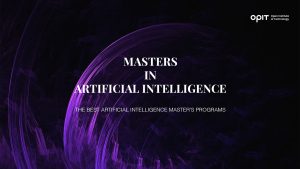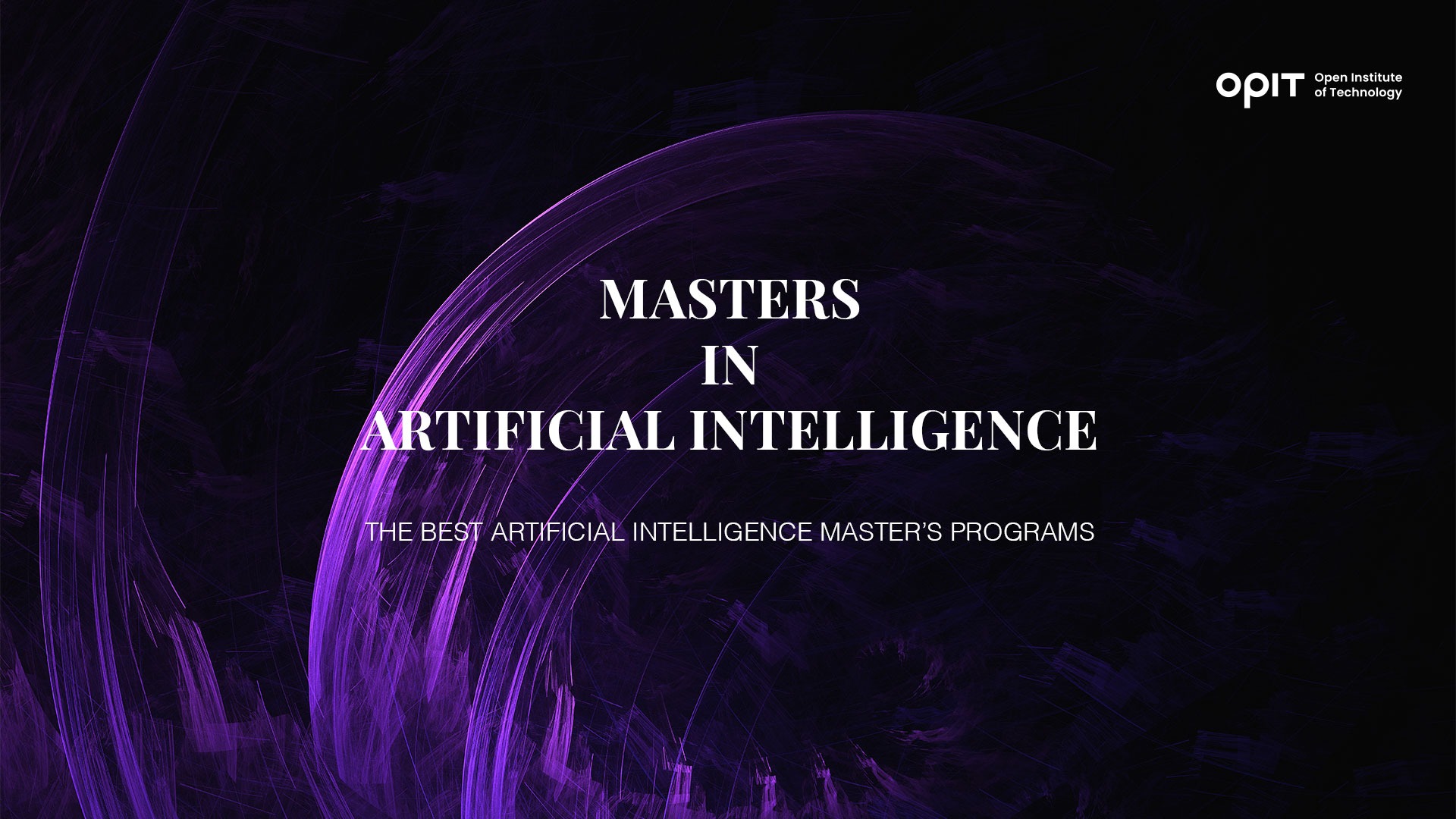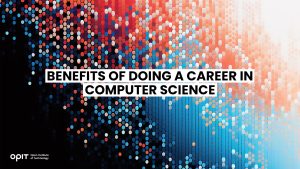

AI and machine learning are like an unstoppable tidal wave in today’s world. We’ve already seen the crest of that wave appear over the horizon with increased automation in businesses and the emergence of apps like ChatGPT. But in the coming years, the wave will engulf the world, making AI big business.
That’s supported by statistics from Statista, too, with reports that the AI market that was worth $200 billion (approx. €185 billion) in 2022 will be worth a staggering $2 trillion (approx. €1.85 trillion) in 2030. The point is that massive growth is coming in AI, and the right Master’s in AI is the key for you to be a part of that growth rather than getting stuck in an industry that gets consumed by it.
Top European Programs for Masters in AI and ML
In choosing the MSc artificial intelligence programs that appear on this list, we looked at factors ranging from the quality (and variety) of course content to who provides the degree. The three courses highlighted here are among Europe’s best to offer to European and overseas students.
Master in Artificial Intelligence (Universita di Bologna)
Though it’s held in Italy, this Master’s program is delivered in English as part of Universita di Bologna’s computer science program. It’s an on-campus course, meaning you’ll have to move to Bologna to attend.
The course provides a solid grounding in the foundations of AI over two years. You’ll get to grips with topics like machine learning and natural language processing, in addition to touching on the ethical and social issues that the rise of AI brings to the table.
The course is welcoming to international students, as it currently has a 77% ratio of international students who don’t come from Bologna. To apply, you must complete an application on the Studenti Online program, along with a mandatory form. Failure to follow this procedure leads to your application being discarded. Applicants don’t necessarily need to hold a Bachelor’s degree, though they must demonstrate a transcript of record that shows they have earned at least 150 ECTS or CFU credits in majors like computer science, mathematics, statistics, and physics.
The course page boasts that 90.5% of its 2021 graduates were happy with their degrees. It’s natural to assume most of these graduates leveraged their Master’s in artificial intelligence to move into careers in the field.
Master in Applied Data Science & AI (OPIT)
If you want to master artificial intelligence with a sprinkling of applying that mastery to the data science industry, OPIT’s course is right for you. It’s an 18-month course (though a 12-month fast-track version is available) that is fully online and delivers 90 ECTS credits. The first term covers the foundational aspects of AI, including subjects like machine learning and data science. But the second term stands out as it moves study from the theoretical to the practical by challenging you to solve real-world problems with your knowledge.
As an online program, it’s available to anybody anywhere, with entry requirements also being flexible. You’ll need a BSc degree, even one from a non-technical field, and should demonstrate English proficiency up to the B2 level with appropriate certification. Don’t worry if you don’t have an English language certification because OPIT offers its own that you can take before registering for the course.
Career-wise, the course is a good option because it occupies an interesting middle-ground between theory and practicality. The second term, in particular, equips you with skills that you can apply directly in fields as varied as IT business analysis, business intelligence, and data science.
MSc in Advanced Computer Science (University of Oxford)
Though it’s not marketed directly as a Master’s in machine learning and artificial intelligence, the University of Oxford’s program gives you excellent qualifications in both. It’s also delivered by an institution that EduRank names as the best for AI in the UK, and sixth-best in the world. The course examines advanced machine learning and computer security techniques, focusing on computational models and the algorithms behind them.
It’s a full-time program demanding 35 hours of weekly study, 15 of which you’ll spend on campus with the other 20 dedicated to self-study. It’s also a tough nut to crack for applicants, as the University of Oxford has a low 18% acceptance rate. You’ll need a first-class undergraduate degree with honors (or an equivalent) in mathematics or computer science to stand a chance of getting into one of the UK’s most prestigious universities.
Those tough entry requirements pay off later on, though, as the words “University of Oxford” on a CV immediately make employers stand up and pay attention. The wide-ranging approach of the program also means you’re not focusing solely on AI, opening up career opportunities in other fields related to math and statistical analysis.
Data Science Master – Europe’s Best Options
Data science is an industry that requires you to translate your understanding of algorithmic theory to transform complex data sets into actionable insights. It’s also an industry that’s making increasingly heavy use of AI tools, making a Master’s in data science a great companion (or alternative) to the best artificial intelligence Master in Europe. As you noticed above, OPIT’s MSc AI program includes elements of data science, though the two programs here (covered in brief) are excellent choices as standalone programs.
MSc Data Sciences and Business Analytics (Essec Business School)
This hybrid course lasts for either one or two years, depending on your background, and focuses on the application of data sciences in a business context. It’s also ranked as the fourth-best Master’s in business analytics in the world by QS World University Rankings.
That high ranking is backed up by the university’s own statistics, which state that over half of its students get jobs before they even complete the course. Essec has a 100% career success rate for graduates in less than six months from completion of the Master’s, making this a great choice for career-focused students. Google, Amazon, JP Morgan Chase, and PwC count as some of the top recruiters that keep their eye on graduates from this program.
Admission requires a degree in a related technical subject, such as engineering, science, or business, from a leading university. That degree also impacts the version of the program you take, as a three-year BSc means you take the two-year Master’s, while those who have a four-year BSc under their belts take the one-year version, assuming they meet other requirements.
Data Science, Technology, and Innovation (University of Edinburgh)
With over 13,000 international students, the University of Edinburgh welcomes overseas students who want to expand their knowledge. Its MSc data science program is no different, buoyed by the fact that it’s an online course that doesn’t require you to move to the less-than-sunny climate of Edinburgh.
It’s a part-time program that relies on self-study, though it provides you with plenty of interactive resources to help along the way. The program is something of an umbrella course as it focuses on equipping students with the knowledge they need to enter the data science field across industries as diverse as medicine, science, and even the arts.
You’ll need the equivalent of an Upper Second-Class Honors degree that has elements of programming before applying. Ideally, you’ll also have evidence of mathematical skill, either through taking math classes in your undergraduate studies or by demonstrating the equivalent of an English A-Level in math through other qualifications.
Factors to Consider When Choosing an Artificial Intelligence Master’s
The five programs highlighted here all help you master artificial intelligence, with many also providing a practical grounding that puts you in good stead for your future career. But if you want to do more research (and that’s always a good idea), the following factors should be on your mind when checking other programs:
- Course Curriculum – The content of your course impacts what you can do once you have your MSc under your belt. Focus on programs that teach tangible skills applicable to the field you wish to enter.
- Faculty – Always check the credentials of the program’s creators and administrators, particularly in terms of industry experience, to confirm they have the relevant tools.
- Tuition and Financial Aid – Master’s programs aren’t cheap (you’ll pay several thousand euros for even an online course), so check you can budget accordingly for the program. Many universities offer financial aid options, from scholarships to student loans, that can help in this area.
- Location – The location isn’t really an issue if you take an online course, but it impacts your decision if you decide to study on-campus. Remember that you’ll spend at least a year of your life on the course (often two years) so you need to gel well with the place in which you’ll live.
- Networking and Industry – Does the course provider have connections to major industry players? Does it offer career advice, ideally via a specialized office or program? These are the types of questions to ask when assessing a university’s capacity for networking and career advancement.
Become a Master in Artificial Intelligence
A Master’s degree in artificial intelligence is your entry point into a growing industry that’s already on the verge of taking the world by storm. That is, assuming you choose the right program. The five highlighted here all land in the “right program” category by virtue of the tuition you receive, the reputation of the institution, and their accessibility to European and overseas students.
Research each program (and any others you consider) extensively before making a choice. Remember that it’s not always about the course or its reputation – it’s about how the course helps you achieve the specific learning goals you need to achieve to get ahead in your chosen career.
Related posts

Life is unpredictable. While many of us have specific hopes and expectations of how our futures will turn out, things don’t always go as expected. There are many variables and unexpected incidents that can interfere and force you to alter your plans, and this is particularly true when it comes to education.
For instance, you might have had plans to study a specific subject, but had to deviate from those plans due to unforeseen circumstances. Or you may have had to enter the workforce in an occupation different from the one you sought in an effort to earn an income, a move that may not provide you with the time or opportunity to achieve your desired educational aims.
In short, every individual’s career pathway is different, and very few go exactly as we expect from the outset. Fortunately, even if you experience a few false starts or sudden twists in your pathway, there are always options available to help you get back on track.
The Unpredictable Nature of Education
In theory, the educational process seems simple. You select a course of study that interests you from the vast array of subjects and prospective professions, select the appropriate classes, acquire the knowledge and skills you need to succeed, and then embark on your profession.
In reality, however, as many people know from firsthand experience, the road to education is often far from straightforward. Here are just some of the many challenges that can take your educational path in a completely different direction:
- Life’s Curveballs: As touched on in the introduction, life is impossible to predict. Financial hardships, health issues, and family emergencies are just some of the unfortunate occurrences that might derail even the most perfectly planned educational regime.
- Changing Interests: People’s desires and preferences don’t necessarily stay the same throughout their entire lives. As you grow, learn, and have new experiences, your interests may change, and so, too, may your educational objectives.
- Pressure and Burnout: Some academic paths are particularly challenging, demanding intense levels of study and hard work. This can sometimes prove too much to bear, even for the most resilient students.
- Failures and Setbacks: Conventional education largely builds around tests and examinations, requiring students to demonstrate their competencies repeatedly. It’s a system that doesn’t suit everyone, and test failures can lead to setbacks and delays.
- Inequality: People can be born with very different privileges and levels of access to education. Those in certain parts of the world may find it much more challenging to complete their education path for financial, cultural, or even political reasons.
- Late Bloomers: People develop at different paces. Some may struggle educationally early on in their lives, forcing them to make certain concessions or sacrifices related to their studies, only to find their feet later in life once they’ve entered the world of work.
Whether you’re a late bloomer, have had your educational aspirations delayed by personal problems, desire to learn new skills and try something different, or want to begin a fresh chapter in your professional life, the Open Institute of Technology (OPIT) may be able to help.
Introducing OPIT
OPIT is an online teaching platform, making high-level technological educational programs accessible to all, no matter their age or background. Offering education in fields like computer science, artificial intelligence, and digital business, OPIT provides a curated collection of degrees. In addition, they offer classes taught by world-leading tutors imparting the wisdom and skills students need to achieve their goals and become the tech leaders of tomorrow.
Meanwhile, for those who have had somewhat tumultuous or unpredictable educational paths, OPIT offers the perfect course corrector: the OPIT Foundation Year.
The OPIT Foundation Year
OPIT’s Foundation Year is a Pre-Tertiary Certificate in Information Technology, fully aligned with MQF/EQF Level 4 standards and valued at 60 ECTS credits. Lasting just one year, this program essentially serves as a comprehensive yet accessible springboard towards higher-level education, creating a path towards degrees and careers in dynamic, flexible fields, like computer science and digital business.
Like other OPIT programs, the Foundation Year is delivered entirely online via the OPIT Virtual Learning Environment. Combining live lectures, asynchronous content, and interactive assessments, students enjoy diverse and dynamic study experiences, acquiring core skills like academic writing, mathematics, and computer literacy, and building a bedrock of knowledge and confidence before taking their next steps.
Who Is the Foundation Program For?
The Foundation Program is designed to provide a solid base upon which to build the technological education many students need. It’s the perfect choice for those who are eager and ambitious to enter professions in AI, data science, and computing, but don’t feel that they have the necessary core skills and knowledge needed to dive straight into a degree.
Entry requirements are relatively relaxed in order to allow as many students as possible to enjoy the benefits of this program. With that said, applicants should ideally hold an MQF/EQF Level 3 or equivalent qualification, with the intention of pursuing a bachelor’s degree. A minimum of B2 level of English proficiency is also required, as this is the working and studying language of the institution.
What the Foundation Year Provides
Perhaps you’ve recently graduated, are considering a career change, or finally have the opportunity to return to education after initial delays or unexpected disruptions to your original plans. Either way, the Foundation Year can help you enjoy:
- Greater Self-Confidence: Foundation Year graduates gain the fundamental skills they need to enter degree programs with much more self-belief and assuredness.
- Superior Tech Knowledge: Lasting two terms, this course explores mathematics, academic reading and writing, and provides an introduction to computer hardware and software.
- Foundational Mathematics: Mathematics literacy forms a large part of the study focus for the Foundation Year, helping students feel more comfortable with numbers and formulas.
- Flexible Learning: Unlike more rigid, conventional education environments, OPIT gives you the freedom and flexibility to study at a pace that suits you best, all from the comfort of home.
- Global Community: OPIT is an international institution, with staff and students from all around the world eager to share knowledge, exchange ideas, and help one another.
Take Your Next Steps to Success With the OPIT Foundation Year
If you’re curious about a career in technology or have always wanted to work with AI, data, and computers, but struggled to find the time and opportunities you need to acquire relevant skills and knowledge, the Foundation Program was made for people like you.
It’s the ideal entry point into the exciting world of online education, and the perfect first step towards a prestigious degree from an innovative and increasingly successful institution. Download the brochure to learn more about it, or start your online application, today.

Students today have a broader range of fields of study to choose from than ever before, but with the world becoming increasingly technological and computers increasing in influence and importance, pursuing a career in computer science often proves a smart, strategic choice.
There are numerous benefits and career paths associated with studying and working in computer science, and we’ll be listing just a few of them in this guide.
High Average Salaries
With the rising cost of living in many parts of the world, it’s unsurprising that many students are thinking several decades ahead to determine what level of starting salaries they could obtain in different career fields.
Many are also seeking professions that offer the opportunity for growth and the ability to advance up the ranks over time, thus increasing their salary and their quality of life in the process.
If a strong, stable salary with the opportunity for improved income is one of your top career priorities, computer science should be at or near the top of your list of prospective careers.
According to recent data, computer scientists earn an average of over €65,000 per year, with certain jobs, like IT project leader and data scientist, paying ever higher. Starting salaries are strong, too, with graduates earning anywhere from €46,000 to €60,000, depending on their chosen profession and level of qualifications.
There are similarly high average salaries reported around the world in computer science and related fields such as data science and AI/ML engineering. These numbers are projected to increase in the years to come, pointing to computer science as a way for graduates to get off to the best financial start of any career.
Unrivaled Flexibility
A common problem with some subjects and courses is that they only provide graduates with a narrow set of skills and a similarly narrow range of potential professions to which they can apply those skills.
That’s not the case with computer science. Graduates in this field can enjoy instant access to a remarkably diverse array of career opportunities, with even newer opportunities being created all the time as technology evolves and innovations emerge.
A few of the many industries and roles you might choose to enter in the field of computer science include:
- Healthcare: As a software developer, data analyst, or cybersecurity expert
- Finance: As a fintech engineer, blockchain developer, or security analyst
- Media: As a graphics programmer, AI developer, or game developer
- Education: As an analyst, software developer, or machine learning engineer
Guaranteed Opportunities
Some career paths are more limited than others, with relatively low numbers of opportunities, recurring risks of job loss, or difficulty obtaining employment in the first place.
Again, with computer science, this simply isn’t the case. At a time when 75% of companies plan to embrace AI and other technologies by 2027, and businesses of all sizes and industries are now relying on computers more than ever before, computer science graduates can enjoy almost unbeatable job security.
Opportunities will continue to grow for people with good computing knowledge, whether that be in the obvious fields like software and web development, engineering, and AI development, or more niche sectors.
With so many options, you’re effectively guaranteed a long, rewarding career if you put in the necessary time and effort needed to establish a strong foundation of computing skills.
Rapidly Expanding and Evolving Industries
It’s no secret that the world of technology is a dynamic and fast-moving one. In the past 20 years alone, we’ve seen the proliferation of the internet, the rapid advancement of smartphones and wearable devices, the emergence of AI, and so much more.
In the years ahead, engineers and developers will continue to explore the boundaries of modern technology’s powers and potential, driving new innovations and improvements and opening more exciting job opportunities for those already established and experienced in this field.
Getting into computer science now could therefore provide a solid foundation for a career filled with excitement as you uncover and explore new ways of working with computers in fields as diverse as healthcare, finance, education, entertainment, manufacturing, logistics, and beyond.
Start Your Computer Science Career at OPIT
We’ve discussed some of the many benefits associated with careers in computer science, from the high starting salaries to the rapidly growing array of job options available to graduates. By now, you may be eager to follow this particular career path and take advantage of the wealth of opportunities.
If you’re wondering how to start, the Open Institute of Technology (OPIT) may hold the answers you need. As an exclusively online learning platform, specializing in computer science and digital business, and staffed by some of the world’s leading tech experts, OPIT is producing the tech leaders of tomorrow.
Some of the many advantages of learning with OPIT include:
- Accessible and flexible online education that matches your learning style and schedule
- Heavy focus on real-world applications of the skills you acquire
- An international community of like-minded students from around the globe
- A top team of tutors and lecturers from varying fields and industries
- Progressive assessment of skills and understanding – not constant exams
OPIT offers a small, curated selection of courses for those seeking to gain the technological skills and knowledge to succeed in their chosen areas of expertise. That includes a BSc (Hons) in Computer Science – a six-term program, worth 180 ECTS credits.
Numerous IT industry leaders and experts helped develop this fully accredited undergraduate degree, which is online and accessible to all. Like other OPIT courses, it offers a flexible learning program, with progressive assessments, fast-track options, and the opportunity to be part of a growing community of learners and tutors.
If the benefits of doing a career in computer science interest you, download the OPIT BSc in Computer Science brochure or fill out an online application today and take your first step toward a rewarding and fulfilling profession.
Have questions?
Visit our FAQ page or get in touch with us!
Write us at +39 335 576 0263
Get in touch at hello@opit.com
Talk to one of our Study Advisors
We are international
We can speak in:


